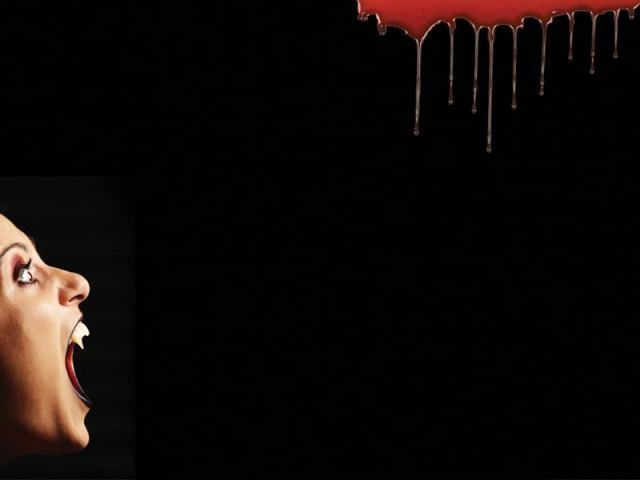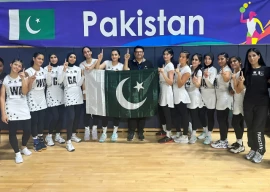
Industrial music thumps in the background as a man wearing latex pants with cutouts over his buttocks, tied to a 6-foot ‘X’-shaped metal stand called a St Andrew’s cross, is being whipped on his behind by a woman sporting a sleek black bob. Along with the S&M fetishists, resident Goths and a variety of underground scenesters, the vampires too have come to play.
One of them sits in a corner of the basement, surrounded by a core group of friends. Wearing knee-high lace up boots and a patent leather corset dress which leaves her pale arms and neck bare, she looks the part of a creature of the night. This is Seregon O’Dassey, and while her official bio describes her as an actress, Seregon says that she is in fact a ‘true vampire’— one of those real-life nosferatu who consider themselves distinct from the Twilight, “True Blood” and other pop culture depictions of the blood-drinking creatures of the night.
Seregon — the pseudonym had been inspired by the games of Dungeons & Dragons she played as a child — is not alone. She is part of a New York-based community of vampires called “The Court of Lazarus”. According to the Atlanta Vampire Alliance (AVA), one of the oldest ‘real vampire’ organisations in the US, New York (or ‘Gotham’ as the vamps prefer to call it) is fang central for America’s Vampires. “There are over 1000 self-identified vampires in New York City alone,” says Merticus, one of the founders of the AVA. They are divided into 30 active Houses, Clans, and Courts, of which the Court of Lazarus is one. The others have equally exotic names, such as the Order of the Black Marble and Temple Sahjaza. Usually presided over by a Vampire regent and a council of Elders, these Houses conduct regular meetings, social activities and have concrete guidelines for members. In short, everything a lonely vampire needs to get by. But no matter what House they belong to, vampires have one thing in common: they need a little ‘extra’ energy to survive. Also, they like to dress in blacks and reds. A lot.
There’s the key word: energy. According to Merticus, “Vampires are individuals who cannot sustain their own physical, mental or spiritual wellbeing without the taking of blood or life force energy from other sources, often human.”
If they don’t get that energy, the consequences can be dire. “Without feeding, a vampire will become lethargic, sickly and depressed,” says Merticus. Okay, so that’s not quite what most people may have imagined. Also, they won’t burst into flames if exposed to sunlight, and seem quite fond of crosses, especially the more gothic looking ones.
Vampires fall into two broad categories: sanguine and psychic. As the name implies, sanguine vampires are blood drinkers, while psychic vampires feed on life energy from consenting or unsuspecting individuals and groups in a process that’s hard to explain and even harder to understand. And like all good sects, the two groups usually don’t get along. For her part, Seregon says she’s a hybrid. “I drink blood on occasion, though only from people I trust,” she says. “A mood will just strike me and I will get this urge. Having a boyfriend helps,” she adds, “but there are also people who I trust that also trust me and are willing to donate.”
Since becoming a vampire, she has drunk the blood of three people, and donated her own to others. Contrary to popular belief, she says, the amount of blood consumed is very little.
”It’s only like maybe a tiny little nick and I just lick that up,” she said. “Blood is a natural diuretic. If you drink 8 ounces you’re going to be in the bathroom very quickly.”
There are no marks visible on her remarkably pale skin. Mostly made on her arms, the incisions were small enough to heal quickly. When she smiles, you can’t help but notice her fang-like canines — the dental feature that vampires are best known for. She may not always use them to draw blood, but to Seregon, her fangs are a manifestation of her nature as a vampire.
No self-respecting vampire would be caught dead without a pair of fangs, and while Seregon claims hers are real, there’s now a whole cottage industry catering to those who aren’t so lucky. Meet the fangsmiths, designers of cutting-edge cuspids who enjoy an elevated status in the vampire community as a result of their skills. Prominent among them is Father Sebastiaan Van Houten, founder of Sanguinarium, the first online vampire community, and co-author of The Black Veil, the vampire code of conduct.
Sebaastian is a self-taught fang artist, a skill he says he learnt while growing up, from observing the work of his dentist father. Lately, he divides his time between New York and Paris, organising vampire-themed parties and selling fangs in various styles. With names like Beast, Interview, Underworld and TruBlood, these faux fangs go for anything between $99 to $399.
Back at the club, a dark-haired man with messy locks starts snapping pictures of the guests. He is also a vampire who goes by the name Dark Shadow Raven X. Seregon poses on the red velvet sofa with her friends, as Raven X snaps away — the purple metal springs coiled in her reddish blond hair lighting up in the flash of the camera. Her watery hazel eyes are almost white against the dark purple eye makeup on her lids, giving her an otherworldly appearance.
Seregon grew up an only child in Pennsylvania, where her mother worked as a nurse and her father was in the Navy. She got into witchcraft as a young girl, though she kept it secret from her peers. She tried her best to fit
in, joining the cheerleading squad in high school, but she always felt like an outsider.
“I read Bram Stoker’s Dracula when I was about 9 or 10,” said Seregon. “That’s what got me into vampires.”
She entered the vampire realm fully by the time she was 18. Lately, though she has been busy with her acting career, she still manages to attend events like the Fixe magazine party, where she can mingle with the community. Amongst her own kind, she comfortably identifies as a vampire. But she says she only ‘comes out of the coffin’ to people who she thinks would understand her way of life-— and outside the community not all her friends know she is a vampire.
It’s stories and experiences like these that prompt John Edgar Browning to consider vampirism to be as legitimate a subculture as any other. Browning, a Phd student at State University of New York has written seven books about vampires, and is currently working on a dissertation about vampires in New Orleans. He traces the popular fetishisation of vampirism back to the 70s and says its rise is very much linked to the popularity of other, related subcultures.
“One of the ways,” he says, “that these early vampires could find donors was by attending S&M conventions and they would find blood fetishists or people who liked being whipped to the point where blood would be present.”
S&M and BDSM networks and clubs, he says, were an important way to find donors and approach them.
Not a vampire himself (although he says he frequently gets asked) Browning said he came to believe in the legitimacy of the subculture after interviewing dozens of vampires in two years of field work. He believes there is a growing interest about vampires within academic circles and that was a sign that vampirism may approach acceptability in mainstream society in the near future. But proving oneself to be a true vampire, he says, remains a great challenge.
“It’s not like vampires have some sort of birthmark where other vampires can just sort of lift up the back of their shirts and say okay they are definitely genuinely a vampire,” he said. “It’s like with gay people, we can’t really prove it either, and you don’t really cross that threshold of becoming gay to other people until you have had sex with the same sex.”
The party is now in full swing and Seregon rises to mingle with the crowd. The man sitting next to her, a friend of hers, turns and says:
”Seregon is queen in this place, but she would be a nobody outside. These people are all misfits in the ‘real’ world, and want to stay hidden, yet they also want to be seen. It’s like look but don’t look.”
But true believers like Seregon and Merticus seem convinced that vampirism is an actual physical condition, and not a supernatural curse. “There is much we don’t understand about our chromosomal makeup and the function of certain genes,” says Merticus. “Many vampires report that they suffer from asthma, chronic fatigue, fibromyalgia and other endocrine system related disorders — this is likely an area medical science will explore more fully in years to come.”
Along with Browning, he believes that vampirism is here to stay, and will attract more interest in times to come. “The pop-culture interest in vampires has led to the intersection of vampire enthusiasts with that of real vampires,” he says. “We find ourselves educating people that vampires are born and not turned (made), that we adhere to ethical and safe feeding practices, are of sound mind and judgment, and productively contribute to society. The vampire will transform according to what desires society is yearning to satiate and I don’t anticipate the interest in vampires waning.”
Published in The Express Tribune, Sunday Magazine, February 12th, 2012.

















COMMENTS
Comments are moderated and generally will be posted if they are on-topic and not abusive.
For more information, please see our Comments FAQ